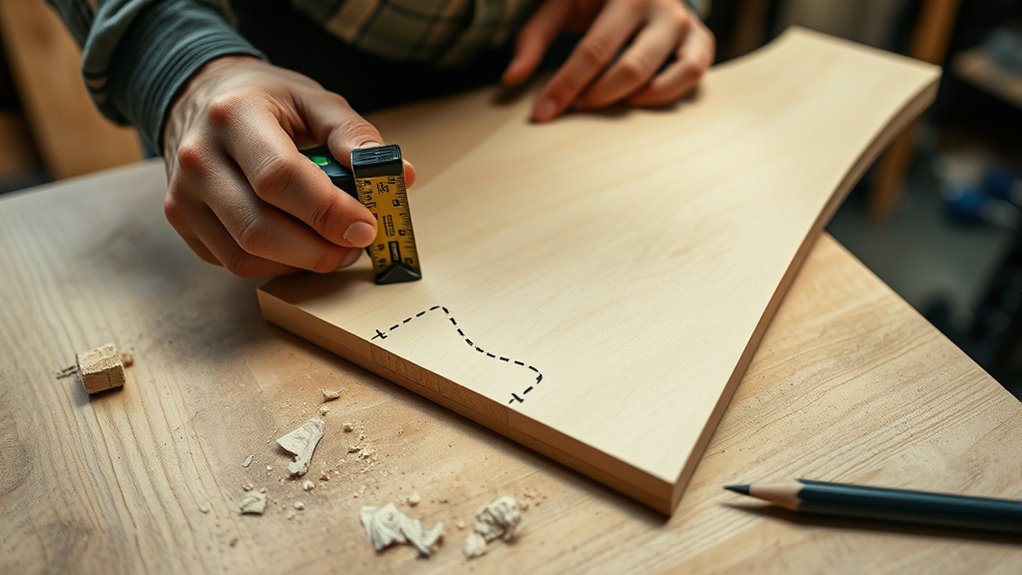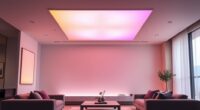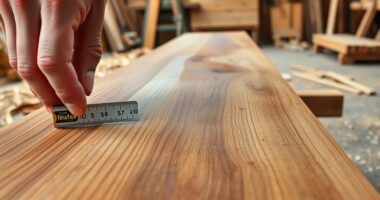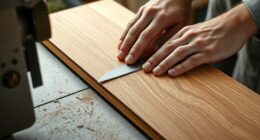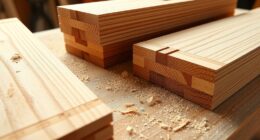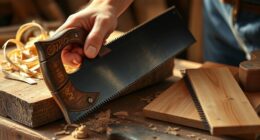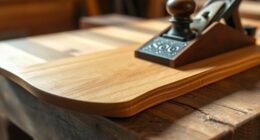To achieve perfect fitted panels, you need to measure accurately using tools like tape measures or laser devices, taking measurements at multiple points to confirm consistency. Add a small allowance—usually 1-2 mm— to account for surface irregularities and material thickness, ensuring a seamless fit. Use scribing techniques to match panels precisely to uneven surfaces, transferring the contour onto the material. Keep these tips in mind, and you’ll master the details that lead to flawless panel installation.
Key Takeaways
- Use precise measuring tools like laser measures and rulers, and measure multiple times to ensure accuracy.
- Incorporate appropriate allowances (1-2 mm) to account for panel thickness and surface irregularities.
- Transfer measurements accurately onto panels using scribing tools or pencils for a perfect fit.
- Scribe along irregular surfaces to trace contours precisely, minimizing gaps and misalignments.
- Record all measurements carefully and double-check before cutting or installing panels.
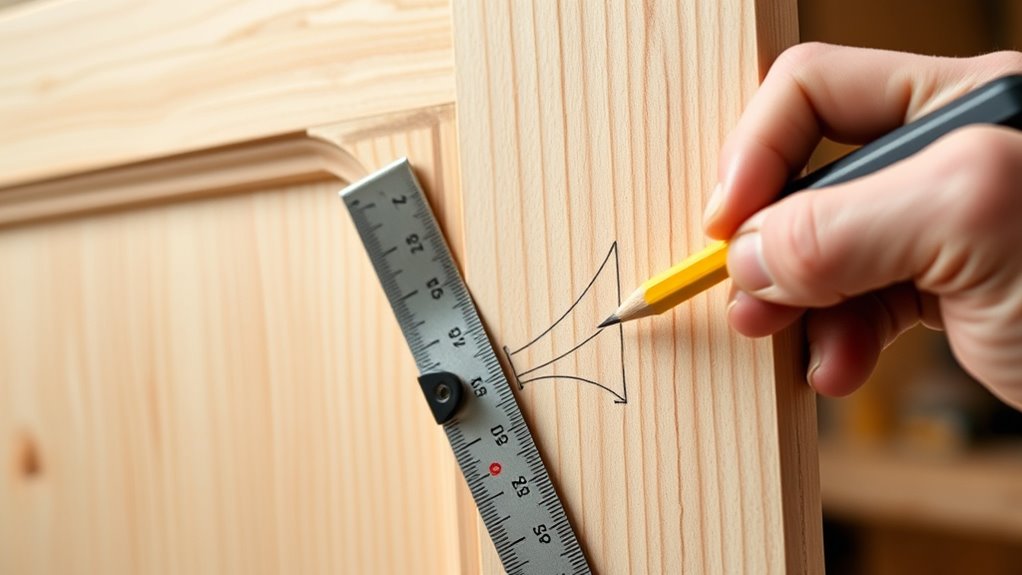
Have you ever struggled to get your fitted panels just right? If so, you’re not alone. Ensuring perfect panel alignment can be tricky, especially when it comes to measuring accurately. The key is using the right measurement tools and understanding how to account for allowances and scribing. When measuring for panels, precision is everything, so take your time and double-check your work. Start by selecting the appropriate measurement tools—tape measures, laser measures, or rulers—whatever works best for your space. The goal is to get exact dimensions that will help your panels fit snugly without gaps or overlaps. Always measure multiple times to confirm your readings, and record each measurement carefully. Remember, a small mistake early on can lead to misaligned panels later, so accuracy is essential from the start.
Once you have your measurements, consider the significance of allowances. Allowances are extra millimeters added or subtracted to your measurements to account for fitting nuances, such as the thickness of the panels or uneven wall surfaces. Without these allowances, your panels might not sit flush or could be difficult to install. Typically, a small allowance of about 1-2 millimeters is added for clearance, but this can vary depending on the material and the installation environment. It’s imperative to understand how to incorporate these allowances into your measurements to guarantee a seamless fit. Additionally, understanding measurement accuracy and how it impacts your results can make all the difference in achieving professional-looking panels.
Adding 1-2mm allowances ensures panels fit perfectly against uneven surfaces.
Scribing is another crucial step in achieving a perfect fit, especially when working with irregular or uneven surfaces. Scribing involves marking the panel to match the exact contours of the wall or surface it will sit against. To do this accurately, you need to use a scribing tool or a pencil and the measurement tools at your disposal. Carefully transfer your measurements onto the panel, then use a scribing tool or a compass to trace the exact shape of the surface. This process allows you to cut the panel precisely, ensuring it conforms perfectly to the contours of your space. By combining careful measurement with proper scribing, you minimize gaps and misalignments, resulting in a clean, professional finish.
Getting your fitted panels right requires attention to detail and patience. Use your measurement tools diligently, add the appropriate allowances, and master the art of scribing. When you do, you’ll end up with panels that align perfectly and look great, transforming your space with minimal fuss. This approach not only saves time during installation but also guarantees a polished, professional result that you’ll be proud of.
Frequently Asked Questions
How Do I Account for Uneven Walls When Measuring?
When measuring for uneven walls, you should first identify any wall irregularities by inspecting the surface closely. Use a long straightedge or level to spot high and low points. Adjust your measurements accordingly by taking multiple readings at different spots, then average these measurements or add specific measurement adjustments to account for dips and bumps. This guarantees your panels fit snugly, even on uneven surfaces.
What Tools Are Best for Precise Scribing?
Think of precise scribing as sketching with a scalpel—your tools need to be sharp and accurate. Use a contour gauge or a flexible profile gauge for precision tools that match uneven surfaces perfectly. Pair these with sharp pencils or marking knives for clean lines, and a straightedge or a scribing block for accuracy. Mastering marking techniques guarantees your panels fit snugly, even on those tricky, uneven walls.
How Do I Adjust Measurements for Panel Expansion?
To adjust measurements for panel expansion, you need to account for temperature and humidity changes that cause panels to expand or contract. Measure the current dimensions accurately, then add or subtract an appropriate allowance based on material type and expected conditions. Always leave a small gap for expansion, especially in humid environments. This guarantees your panels fit perfectly without warping or buckling over time.
What Are Common Mistakes in Measuring for Fitted Panels?
Mistakes mar your measurements when you neglect panel material considerations and aesthetic design principles. You might measure too tightly, ignoring expansion allowances, or too loosely, causing gaps. Failing to account for the unique properties of materials like wood or glass can lead to misfits. You also overlook precise placement, leading to uneven edges. Always double-check, consider material behaviors, and prioritize aesthetic harmony to guarantee perfect panel fitting.
How Do I Measure for Irregularly Shaped Panels?
To measure for irregularly shaped panels, you need to take precise, irregular measurements of each edge and corner. Use a flexible measuring tape for custom panel shapes, guaranteeing you record every detail. Mark these measurements carefully, noting any angles or curves. When ordering, communicate these irregular measurements clearly to ensure the panel fits perfectly. Accurate measurements prevent fitting issues and ensure your custom panel shapes look seamless.
Conclusion
By mastering allowances and scribes, you guarantee your panels fit flawlessly, turning measurement into artistry. Precision becomes your ally, where small margins make a big difference, and accuracy transforms the ordinary into the extraordinary. Just as a painter’s brush defines their masterpiece, your careful calculations shape perfect fitting panels. In this dance of measurement and craftsmanship, the difference lies not only in tools but in your attention—making the imperfectly measured become perfectly crafted.
